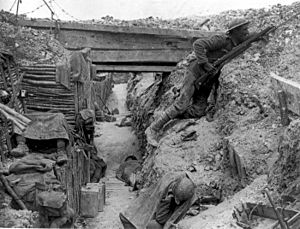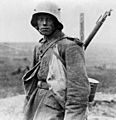Western Front (World War I) facts for kids
Quick facts for kids Western Front |
|||||||
|---|---|---|---|---|---|---|---|
| Part of World War I | |||||||
 For most of World War I, Allied and German Forces were stalled in trench warfare along the Western Front. This picture shows a sentry of A Company, 11th Battalion, The Cheshire Regiment in a trench during the Battle of the Somme. |
|||||||
|
|||||||
| Belligerents | |||||||
|
|||||||
| Commanders and leaders | |||||||
| No unified command until 1918, then Ferdinand Foch | Moltke → Falkenhayn → Hindenburg and Ludendorff → Hindenburg and Groener | ||||||
| Casualties and losses | |||||||
| ~4,800,000 | Unknown | ||||||
The Western Front was a very important battle line during World War I. It was located in Belgium and France. In 1914, the German army invaded Luxembourg and Belgium. This started the fighting on the Western Front.
The German army quickly took control of many important industrial areas in France. But their fast advance was stopped at the Battle of the Marne. After this, both sides began to dig long, defensive trenches. These trenches eventually stretched all the way from the North Sea to the border of Switzerland.
Contents
What Was the Western Front?
The Western Front was a long line of trenches where soldiers fought during World War I. It was a key area of conflict for four years. From 1915 to 1917, many attacks were launched from these trenches. Both sides used a lot of artillery (large guns) and thousands of infantry (foot soldiers).
Why Was the Western Front a Stalemate?
The fighting on the Western Front often resulted in a stalemate. This means neither side could make a big breakthrough. The trenches were very strong, protected by machine gun nests and barbed wire. Artillery fire also made it hard to advance.
New military technologies were developed to try and break this deadlock. These included poison gas, aircraft, and tanks. However, even with these new weapons, major breakthroughs were rare. Both sides were very determined not to lose any land. This led to a long and difficult war with many casualties.
Images for kids
-
Map of the Western Front and the Race to the Sea, 1914
-
Ruins of Carency after it was recaptured by France
-
The Hindenburg Line at Bullecourt seen from the air
See also
 In Spanish: Frente occidental (Primera Guerra Mundial) para niños
In Spanish: Frente occidental (Primera Guerra Mundial) para niños










